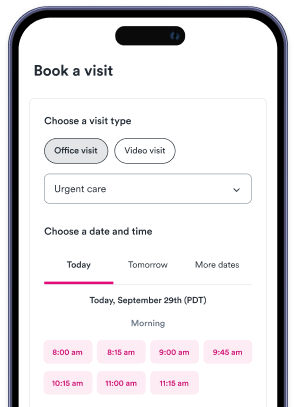Key points
- Headaches are a common symptom of colds, often caused by congestion, sinus pressure, or dehydration; understanding the types can aid in symptom management.
- Various viruses can cause colds, leading to symptoms like runny nose, sore throat, sneezing, cough, fatigue, and headaches; rhinoviruses are the most common cause.
- Different types of headaches associated with colds include sinus headaches due to inflammation and congestion, dehydration headaches due to fluid loss, and cough headaches due to strain on head and neck muscles.
- Cold-related headaches can be managed through rest, hydration, decongestants, steam inhalation, nasal sprays, and pain relievers; medical attention is necessary if symptoms persist beyond 10 days or are accompanied by high fever, chills, severe body aches, dizziness, or vision changes.

What causes a common cold?
According to the AAO, the common cold is caused by a variety of viruses that invade the upper respiratory tract, leading to a range of symptoms, including headaches. Some of the key viruses that may cause a headache alongside a cold:
-
Rhinoviruses: The most common cause of colds, responsible for up to 50% of cases.
-
Human metapneumovirus (HMPV): A virus that can lead to respiratory infections, particularly in children and the elderly.
-
Human parainfluenza virus (HPIV): Known for causing respiratory illnesses, including croup and colds.
-
Coronavirus: Is the virus responsible for COVID-19 but several other strains of it can lead to common cold symptoms.
-
Adenoviruses: These can cause a range of illnesses, including colds, and are known for their ability to spread easily.
-
Respiratory syncytial virus (RSV): A common virus that can cause mild, cold-like symptoms but may lead to more serious respiratory issues in infants and older adults.
Understanding the specific viruses responsible for these infections can provide insight into how colds develop and why they can sometimes be accompanied by discomfort.
Cold symptoms
Colds are a prevalent illness that affects adults an average of three times per year, according to the AAO, and often lead to a range of uncomfortable symptoms. These symptoms can vary in intensity and duration, making it important to recognize them for effective management and recovery. Some typical symptoms associated with the common cold include:
-
Runny nose: Increased mucus production leading to nasal congestion.
-
Scratchy throat: A common early symptom that can develop into soreness.
-
Sneezing: A reflex action triggered by irritation in the nasal passages.
-
Cough: Often develops as a response to throat irritation or mucus buildup.
-
Decreased appetite: A result of general malaise and discomfort.
-
Muscle aches: Mild body aches can occur as the body fights off the virus.
-
Sore throat: Inflammation and pain in the throat area, often exacerbated by coughing.
-
Fatigue: A general feeling of tiredness and lack of energy.
-
Headache: Often caused by sinus pressure or general illness.
-
Fever: Mild fever may occur, especially in children.
Sinus headache
Sinus headaches are a common type of headache that often occur as a result of sinus inflammation and congestion, typically associated with a cold or sinus infection according to The National Headache Foundation. They explain that when the sinuses become blocked due to swelling or excess mucus, pressure builds up in the sinus cavities, leading to discomfort and pain. This type of headache can be particularly debilitating, as it often presents with a throbbing sensation in the forehead, cheeks or around the eyes, and can be accompanied by other cold symptoms such as nasal congestion and facial tenderness.
The pain from a sinus headache is usually localized to the areas where the sinuses are located, and it may worsen when bending over or lying down. Individuals may also experience a feeling of fullness in the ears, along with a runny or stuffy nose. Unlike tension headaches or migraines, sinus headaches are directly linked to sinus issues and often improve as the underlying sinus congestion resolves. Effective treatments may include decongestants, nasal sprays and pain relievers, as well as home remedies like steam inhalation to help alleviate symptoms and promote drainage, according to The National Headache Foundation.
Dehydration headaches
According to the National Headache Foundation, when the body is fighting off an infection, such as a cold, it may require additional fluids to support the immune response and maintain proper hydration levels. However, symptoms like fever, nasal congestion and a sore throat can lead to decreased fluid intake, while increased mucus production can result in fluid loss, contributing to dehydration. As the body becomes dehydrated, it can trigger headaches, adding to the discomfort already caused by the cold.
The mechanism behind dehydration headaches involves the brain temporarily shrinking due to a lack of fluids, which can lead to pain and discomfort. This type of headache may be exacerbated by other cold symptoms, such as fever and sweating, which further increase fluid loss. To prevent dehydration headaches while dealing with a cold, it is essential to stay well-hydrated by drinking plenty of fluids, such as water, herbal teas and broths. Additionally, consuming hydrating foods, like fruits and vegetables, can help replenish lost fluids and alleviate headache symptoms, allowing for a more comfortable recovery.
Cough headaches
When a cold triggers a cough, the repeated strain on the muscles in the head and neck can lead to tension and discomfort, resulting in a headache. This type of headache is typically characterized by a dull, throbbing pain that may intensify with each cough or sneeze, making it particularly bothersome for individuals already suffering from cold symptoms.
The mechanism behind cough headaches involves the sudden increase in pressure within the skull during coughing episodes. This pressure can irritate the surrounding tissues and nerves, leading to pain. Additionally, the inflammation and congestion caused by a cold can contribute to sinus pressure, further exacerbating headache symptoms. To alleviate cough headaches, it is important to manage the underlying cough through appropriate treatments, such as cough suppressants or expectorants, while also staying hydrated and resting.
How to treat a cold with a headache
While it's essential to monitor symptoms and seek medical advice if they persist, there are several strategies that can help alleviate discomfort and promote recovery, according to the National Headache Foundation:
-
Rest: Allowing your body to rest is crucial for recovery. Sleep helps the immune system function optimally, which can reduce symptoms and headaches.
-
Drink fluids: Staying hydrated is essential, as fluids help thin mucus and prevent dehydration, which can contribute to headaches. Aim for water, herbal teas and clear broths.
-
Decongestants: Over-the-counter decongestants can help relieve nasal congestion, reducing sinus pressure and alleviating headache pain. Be sure to follow the dosage instructions on the label.
-
Steam: Inhaling steam from a hot shower or a bowl of hot water can help open up nasal passages, easing congestion and providing relief from sinus pressure that may be causing headaches.
-
Nasal spray: Saline nasal sprays can help moisturize nasal passages and reduce congestion, leading to less pressure in the sinuses and a decrease in headache symptoms.
-
Pain relievers: Over-the-counter pain relievers, such as ibuprofen or acetaminophen, can help reduce headache pain and provide relief from other cold symptoms.
When to see a doctor for a headache with a cold
While many headaches associated with a cold can be managed at home, there are certain signs that indicate it may be time to seek medical attention, notes the National Headache Foundation:
-
Symptoms last longer than 10 days: If your headache and cold symptoms persist beyond this time frame, it may indicate a more serious infection or condition that requires medical evaluation.
-
Fever: A high fever (typically above 101°F or 38.3°C) can be a sign of a more severe infection, such as the flu or a sinus infection, and warrants a doctor's visit.
-
Chills: Experiencing chills along with a headache and cold symptoms may suggest a more significant infection that needs to be assessed by a healthcare professional.
-
Muscle or body aches: Severe muscle pain or body aches that accompany your headache may indicate a systemic infection, such as the flu, which may require medical intervention.
-
Dizziness: If you experience dizziness or lightheadedness in conjunction with your headache and cold symptoms, it could be a sign of dehydration or another underlying issue that should be evaluated by a healthcare professional.
-
Vision changes: Any sudden changes in vision, such as blurriness or double vision, alongside a headache, should be addressed immediately as they could signal a more serious condition.
Being aware of these warning signs can help ensure timely medical care and a more effective recovery from your cold and associated headaches.
Urgent care near me
Solv offers a convenient way to search for nearby urgent care centers that can provide the necessary treatment for your symptoms. With easy access to healthcare providers who understand the discomfort of sinus headaches, you can receive the care you need without the hassle of long wait times. Take charge of your health and find the right care quickly with SolvHealth, ensuring you get back to feeling your best in no time.
FAQs
What causes headaches during a common cold?
Headaches during a common cold are often the result of congestion, sinus pressure, or dehydration. Different types of headaches can be associated with a cold, including sinus headaches, dehydration headaches, and cough headaches.
What are the typical symptoms of a common cold?
Typical symptoms of a common cold include a runny nose, scratchy or sore throat, sneezing, cough, decreased appetite, muscle aches, fatigue, headache, and sometimes a mild fever, especially in children.
How can I treat a headache associated with a cold?
Treatment for a headache associated with a cold can include rest, staying hydrated, using over-the-counter decongestants, inhaling steam, using saline nasal sprays, and taking over-the-counter pain relievers. It's important to manage the underlying symptoms of the cold to help alleviate the headache.
When should I seek medical attention for a headache with a cold?
You should seek medical attention if your headache and cold symptoms last longer than 10 days, if you have a high fever, experience chills, have severe muscle or body aches, feel dizzy or lightheaded, or have sudden changes in vision. These could be signs of a more serious infection or condition that requires medical evaluation.
What viruses can cause a common cold and associated headache?
Several viruses can cause a common cold and associated headache, including Rhinoviruses, Human metapneumovirus (HMPV), Human parainfluenza virus (HPIV), Coronavirus, Adenoviruses, and Respiratory syncytial virus (RSV).











